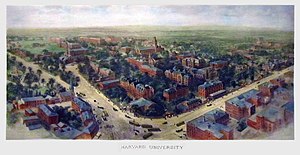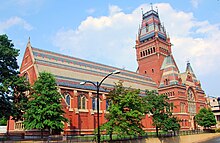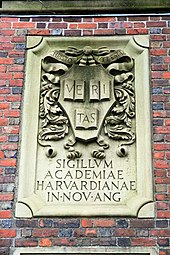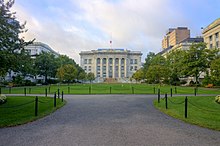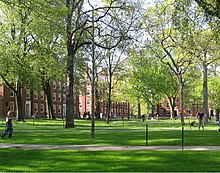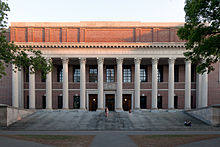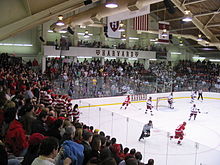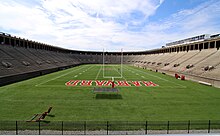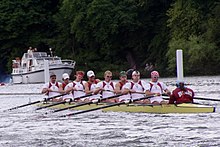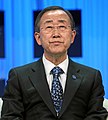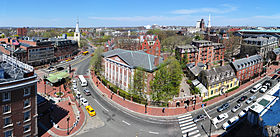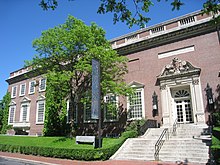جامعة هارفارد
Harvard University

Jump to navigation Jump to search

|
|
| Latin: Universitas Harvardiana | |
|
Former names
|
Harvard College |
|---|---|
| Motto | Veritas[1][2] |
|
Motto in English
|
Truth |
| Type | Private nonprofit university |
| Established | 1636[3] |
| Endowment | $40.9 billion[4] |
| President | Lawrence Bacow |
|
Academic staff
|
~2,400 faculty members (and >10,400 academic appointments in affiliated teaching hospitals)[5] |
| Students | 20,739 (Fall 2018)[6] |
| Undergraduates | 6,788 (Fall 2018)[6] |
| Postgraduates | 13,951 (Fall 2018)[6] |
| Location |
, , United States
|
| Campus | Urban 209 acres (85 ha) |
| Newspaper | The Harvard Crimson |
| Colors | Crimson[5] |
| Athletics | NCAA Division I – Ivy League |
| Nickname | Harvard Crimson |
| Affiliations | NAICU AICUM AAU URA |
| Website | harvard |
Harvard University is a private Ivy League research university in Cambridge, Massachusetts, with about 6,800 undergraduate students and about 14,000 postgraduate students. Established in 1636 and named for its first benefactor, clergyman John Harvard, Harvard is the United States’ oldest institution of higher learning.[7] Its history, influence, wealth, and academic reputation have made it one of the most prestigious universities in the world.[8][9][10][11][12][13]
The Massachusetts Great and General Court authorized Harvard’s founding. In its early years, Harvard College primarily trained Congregational and Unitarian clergy, although it has never been formally affiliated with any denomination. Its curriculum and student body were gradually secularized during the 18th century, and by the 19th century, Harvard had emerged as the central cultural establishment among Boston elites.[14][15] Following the American Civil War, President Charles W. Eliot‘s long tenure (1869–1909) transformed the college and affiliated professional schools into a modern research university; Harvard was a founding member of the Association of American Universities in 1900.[16] A. Lawrence Lowell, who succeeded Eliot, further reformed the undergraduate curriculum and undertook aggressive expansion of Harvard’s land holdings and physical campus. James Bryant Conant led the university through the Great Depression and World War II; he began to liberalize admissions after the war.
The university is composed of eleven principal academic units—ten faculties and the Radcliffe Institute for Advanced Study—with campuses throughout Greater Boston:[17] its 209-acre (85 ha) original undergraduate campus is centered on Harvard Yard in Cambridge, approximately 3 miles (5 km) northwest of Boston; the business school and many athletics facilities, including Harvard Stadium, are across the Charles River in the Allston neighborhood of Boston; and the medical, dental, and public health schools are in the Longwood Medical Area.[18] Harvard’s endowment is worth $40.9 billion, making it the largest of any academic institution.[4] Harvard is a large, highly residential research university.[19] While the nominal cost of attendance is high, the university’s sizeable endowment allows it to offer generous, no-loan financial aid packages and use need-blind admission.[20] The Harvard Library is the world’s largest academic library system, comprising 79 individual libraries holding about 20.4 million items.[21][22][23][24]
Harvard’s alumni include 8 U.S. presidents, more than 30 foreign heads of state, 188 living billionaires, 369 Rhodes Scholars, and 252 Marshall Scholars.[25][26][27] As of March 2020, 160 Nobel laureates, 18 Fields Medalists, and 14 Turing Award winners have been affiliated as students, faculty, or researchers.[28] In addition, Harvard students and alumni have won 10 Academy Awards, 48 Pulitzer Prizes, and 108 Olympic medals (46 gold, 41 silver, and 21 bronze), and founded many notable companies worldwide.[29][30][31]
History
Colonial
Harvard was established in 1636 by vote of the Great and General Court of the Massachusetts Bay Colony. In 1638, it acquired British North America‘s first known printing press.[32][33] In 1639, it was named Harvard College after deceased clergyman John Harvard, an alumnus of the University of Cambridge, who had left the school £779 and his library of some 400 volumes.[34] The charter creating the Harvard Corporation was granted in 1650.
A 1643 publication gave the school’s purpose as “to advance learning and perpetuate it to posterity, dreading to leave an illiterate ministry to the churches when our present ministers shall lie in the dust”;[35] in its early years trained many Puritan ministers.[36] It offered a classic curriculum on the English university model—many leaders in the colony had attended the University of Cambridge—but conformed to the tenets of Puritanism. It was never affiliated with any particular denomination, but many of its earliest graduates went on to become clergymen in Congregational and Unitarian churches.[37]
Increase Mather served as president from 1681 to 1701. In 1708, John Leverett became the first president who was not also a clergyman, marking a turning of the college away from Puritanism and toward intellectual independence.[38]
19th century
In the 19th century, Enlightenment ideas of the power of reason and free will were widespread among Congregational ministers, putting those ministers and their congregations in tension with more traditionalist, Calvinist parties.[39]:1–4 When Hollis Professor of Divinity David Tappan died in 1803 and President Joseph Willard died a year later, a struggle broke out over their replacements. Henry Ware was elected to the chair in 1805, and the liberal Samuel Webber was appointed to the presidency two years later, signaling the shift from the dominance of traditional ideas at Harvard to the dominance of liberal, Arminian ideas (defined by traditionalists as Unitarian ideas).[39]:4–5[40]:24
In 1846, the natural history lectures of Louis Agassiz were acclaimed both in New York and on the campus at Harvard College. Agassiz’s approach was distinctly idealist and posited Americans’ “participation in the Divine Nature” and the possibility of understanding “intellectual existences.” Agassiz’s perspective on science combined observation with intuition and the assumption that a person can grasp the “divine plan” in all phenomena. When it came to explaining life-forms, Agassiz resorted to matters of shape based on a presumed archetype for his evidence. This dual view of knowledge was in concert with the teachings of Common Sense Realism derived from Scottish philosophers Thomas Reid and Dugald Stewart, whose works were part of the Harvard curriculum at the time. The popularity of Agassiz’s efforts to “soar with Plato” probably also derived from other writings to which Harvard students were exposed, including Platonic treatises by Ralph Cudworth, John Norris and, in a Romantic vein, Samuel Taylor Coleridge. The library records at Harvard reveal that the writings of Plato and his early modern and Romantic followers were almost as regularly read during the 19th century as those of the “official philosophy” of the more empirical and more deistic Scottish school.[41]
Charles W. Eliot, president 1869–1909, eliminated the favored position of Christianity from the curriculum while opening it to student self-direction. While Eliot was the most crucial figure in the secularization of American higher education, he was motivated not by a desire to secularize education, but by Transcendentalist Unitarian convictions. Derived from William Ellery Channing and Ralph Waldo Emerson, these convictions were focused on the dignity and worth of human nature, the right and ability of each person to perceive truth, and the indwelling God in each person.[42]
In 1876, Harvard became the first American university to award a PhD in economics.[43]
20th century
During the 20th century, Harvard’s international reputation grew as a burgeoning endowment and prominent professors expanded the university’s scope. Rapid enrollment growth continued as new graduate schools were begun and the undergraduate college expanded. Radcliffe College, established in 1879 as sister school of Harvard College, became one of the most prominent schools for women in the United States. Harvard became a founding member of the Association of American Universities in 1900.[16]
In the early 20th century, the student body was predominantly “old-stock, high-status Protestants, especially Episcopalians, Congregationalists, and Presbyterians,” a group later called “WASPs.” A 1923 proposal by President A. Lawrence Lowell that Jews be limited to 15% of undergraduates was rejected, but Lowell did ban blacks from Harvard Yard, writing that “forcing” blacks and whites to live together “would increase a prejudice that … is most unfortunate and probably growing.”[45][46][47][48]
President James Bryant Conant reinvigorated creative scholarship to guarantee Harvard’s preeminence among research institutions. He saw higher education as a vehicle of opportunity for the talented rather than an entitlement for the wealthy, so Conant devised programs to identify, recruit, and support talented youth. In 1943, he asked the faculty to make a definitive statement about what general education ought to be, at the secondary as well as at the college level. The resulting Report, published in 1945, was one of the most influential manifestos in 20th century American education.[49]
Between 1945 and 1960, admissions were opened up to bring in a more diverse group of students. No longer drawing mostly from rich alumni of select New England prep schools, the undergraduate college was now open to striving middle class students from public schools; many more Jews and Catholics were admitted, but few blacks, Hispanics, or Asians.[50] Throughout the rest of the 20th century, Harvard became more diverse.[51]
Harvard’s graduate schools began admitting women in small numbers in the late 19th century. During World War II, students at Radcliffe College (which since 1879 had been paying Harvard professors to repeat their lectures for women) began attending Harvard classes alongside men.[52] Women were first admitted to Harvard Medical School in 1945.[53] Since 1971, Harvard has controlled essentially all aspects of undergraduate admission, instruction, and housing for Radcliffe women. In 1999, Radcliffe was formally merged into Harvard.[54]
21st century
Drew Gilpin Faust, previously the dean of the Radcliffe Institute for Advanced Study, became Harvard’s first woman president on July 1, 2007.[55] She was succeeded by Lawrence Bacow on July 1, 2018.[56]
In February 2020, the United States Department of Education started an investigation into whether Harvard University failed to properly report hundreds of millions of dollars in foreign gifts and contracts. This investigation is part of a growing probe by US federal agencies into whether China and other countries gained inappropriate influence and access into American higher education.[57]
With the launch of the Harvard Financial Aid Initiative in 2004, the 21st century also saw an increased emphasis on providing financial aid to promote access for students from all economic backgrounds.[58] Since 2004, there have been several significant expansions of Harvard’s financial aid program.[59][60][61] As of 2020, more than half of Harvard College students receive loan-free scholarship aid from the university.[62]
Campuses
Cambridge
Harvard’s 209-acre (85 ha) main campus is centered on Harvard Yard in Cambridge, about 3 miles (5 km) west-northwest of downtown Boston, and extends into the surrounding Harvard Square neighborhood. Harvard Yard itself contains key administrative offices such as University Hall and Massachusetts Hall; libraries such as Widener, Pusey, Houghton, and Lamont; Memorial Church; academic buildings such as Sever Hall and Harvard Hall; and most freshman dormitories. Sophomore, junior, and senior undergraduates live in twelve residential houses, nine of which are south of Harvard Yard along or near the Charles River. The other three are located in a residential neighborhood half a mile northwest of the Yard at the Quadrangle (commonly referred to as the “Quad”) which housed Radcliffe College students until Radcliffe merged its residential system with Harvard. Each residential house is a community with undergraduates, faculty deans, and resident tutors, as well as a dining hall, library, and recreational spaces.[63] The houses were made possible by a gift from Yale University alumnus Edward Harkness.[64]
Radcliffe Yard, formerly the center of the campus of Radcliffe College and now home to Harvard’s Radcliffe Institute for Advanced Study,[65] is adjacent to the Graduate School of Education and the Cambridge Common.
Between 2014 and 2016, Harvard University reported crime statistics for its main Cambridge campus that included 141 forcible sex offenses, 33 robberies, 46 aggravated assaults, 151 burglaries, and 32 cases of motor vehicle theft.[66]
Harvard also has commercial real estate holdings in Cambridge and Allston, on which it pays property taxes.[67] This includes the Allston Doubletree Hotel, The Inn at Harvard, and the Harvard Square Hotel.[68]
Allston
Harvard Business School and many athletics facilities, including Harvard Stadium, are located on a 358-acre (145 ha) campus in Allston,[69] a Boston neighborhood just across the Charles River from the Cambridge campus. The John W. Weeks Bridge, a pedestrian bridge over the Charles River, connects the two campuses.
Intending a major expansion, Harvard now owns more land in Allston than it does in Cambridge.[70] A ten-year plan calls for 1.4 million square feet (130,000 square meters) of new construction and 500,000 square feet (50,000 square meters) of renovations, including new and renovated buildings at Harvard Business School, a hotel and conference center, a multipurpose institutional building, renovations to graduate student housing and Harvard Stadium, new athletics facilities, new laboratories and classrooms for the Harvard John A. Paulson School of Engineering and Applied Sciences (SEAS), expansion of the Harvard Education Portal, and a district energy facility.[71]
In June 2020, SEAS will expand into the new, 500,000+ square foot Science and Engineering Complex (SEC) in Allston.[72] The SEC will be adjacent to the Enterprise Research Campus in synergy with Harvard Business School and the Harvard Innovation Lab to encourage technology- and life science-focused startups as well as collaborations with mature companies.[73]
Longwood
Harvard Medical School, the Harvard School of Dental Medicine, and the Harvard T.H. Chan School of Public Health are located on a 21-acre (8.5 ha) campus in the Longwood Medical and Academic Area in Boston about 3.3 miles (5.3 km) south of the Cambridge campus.[18] Several of Harvard’s affiliated hospitals and research institutes are also in Longwood, including Beth Israel Deaconess Medical Center, Boston Children’s Hospital, Brigham and Women’s Hospital, Dana–Farber Cancer Institute, Joslin Diabetes Center, and the Wyss Institute for Biologically Inspired Engineering. Additional affiliates, most notably Massachusetts General Hospital, are located throughout the Greater Boston area.
Other
Harvard also owns and operates the Dumbarton Oaks Research Library and Collection in Washington, D.C., the Harvard Forest in Petersham, Massachusetts, the Concord Field Station in Estabrook Woods in Concord, Massachusetts,[74] the Villa I Tatti research center in Florence, Italy,[75] the Harvard Shanghai Center in Shanghai, China,[76] and the Arnold Arboretum in the Jamaica Plain neighborhood of Boston.
Organization and administration
Governance
| College/school | Year founded |
| Harvard College | 1636 |
| Medicine | 1782 |
| Divinity | 1816 |
| Law | 1817 |
| Dental Medicine | 1867 |
| Arts and Sciences | 1872 |
| Business | 1908 |
| Extension | 1910 |
| Design | 1914 |
| Education | 1920 |
| Public Health | 1922 |
| Government | 1936 |
| Engineering and Applied Sciences | 2007 |
Harvard is governed by a combination of its Board of Overseers and the President and Fellows of Harvard College (also known as the Harvard Corporation), which in turn appoints the President of Harvard University.[77] There are 16,000 staff and faculty,[78] including 2,400 professors, lecturers, and instructors.[79]
The Faculty of Arts and Sciences is the largest Harvard faculty and has primary responsibility for instruction in Harvard College, the Graduate School of Arts and Sciences, and the Division of Continuing Education, which includes Harvard Summer School and Harvard Extension School. There are nine other graduate and professional faculties as well as the Radcliffe Institute for Advanced Study.
Joint programs with the Massachusetts Institute of Technology include the Harvard–MIT Program in Health Sciences and Technology, the Broad Institute, The Observatory of Economic Complexity, and edX.
Endowment
Harvard has the largest university endowment in the world, valued at about $40.9 billion as of 2019.[4] During the Great Recession, it suffered significant losses that forced large budget cuts, but the endowment has since recovered.[80][81][82][83][84][85] One of the most visible results of Harvard’s attempt to re-balance its budget was their halting[84] of construction of the $1.2 billion Allston Science Complex that had been scheduled to be completed by 2011, resulting in protests from local residents.[86]
Since 2016, Narv Narvekar has been the CEO of the endowment.[87] Almost $2 billion annually is distributed from the endowment to fund operations.[87] Harvard’s ability to fund its degree and financial aid programs is highly dependent on the performance of its endowment; a poor performance in fiscal year 2016 led to a 4.4% cut in the number of graduate students funded by the Faculty of Arts and Sciences.[88] Endowment income is critical as only 22% of revenue is from tuition, fees, room, and board.[89]
Divestment
Since the 1970s, several campaigns have sought to divest Harvard’s endowment from holdings the campaigns opposed, including investments in apartheid South Africa, the tobacco industry, Sudan during the Darfur genocide, the fossil fuel industry, and the private prison industry.[90][91]
During the divestment from South Africa movement in the late 1980s, student activists erected a symbolic “shantytown” on Harvard Yard and blockaded a speech by South African Vice Consul Duke Kent-Brown.[92][93] But the Harvard Management Company repeatedly refused to divest, responding that “operating expenses must not be subject to financially unrealistic strictures or carping by the unsophisticated or by special interest groups.”[94] Eventually, the university reduced its South African holdings by $230 million (out of $400 million) in response to the pressure.[92][95]
Academics
Admissions
Harvard’s undergraduate admissions process is characterized by the Carnegie Foundation as “more selective, lower transfer-in.”[19] Admission is based on academic prowess, extracurricular activities, and personal qualities. For the undergraduate class of 2022, Harvard had 42,749 applicants, accepting 2,024 (4.7%) and enrolling 1,653.[96] The middle 50% range of SAT scores of enrolled freshmen was 720–780 for reading and writing and 740–800 for math, while the middle 50% range of the ACT composite score was 33–35.[96] The average high school grade point average (GPA) was 4.18.[96]
Harvard College ended its early admissions program in 2007 as the program was believed to disadvantage low-income and minority applicants applying to selective universities, but for the class of 2016 and beyond, an early action program was reintroduced.[97] The freshman class that entered in the fall of 2017 was the first to be predominantly (50.8%) nonwhite.[98]
A federal lawsuit alleges that Harvard’s admissions policies discriminate against Asian Americans, who tend to be overrepresented among students with high academic achievement.[99][100] A 2019 district court decision in the case (which has since been appealed) found no evidence of explicit racial bias but did not rule out a small amount of implicit bias.[101] Harvard has implemented more implicit bias training for its admissions staff in accordance with the court’s recommendations.[102][103]
Harvard’s admissions preference for children of alumni, employees, and donors has been criticized as favoring white and wealthy candidates.[104][105] One study based on data made public by the lawsuit found that from 2014 to 2019, 43% of white students admitted were children of alumni or employees, relatives of donors, or recruited athletes. The authors estimated about three-quarters of these students would have been rejected had they been considered as white students not falling into one of these categories.[106]
As of the 2019–2020 academic year, Harvard College tuition was about $48,000, contributing to about $70,000 in billed costs.[20] Harvard’s extensive fundraising allows it to offer one of the most generous financial aid programs in the country, with need-blind admission and 100% of demonstrated financial need met for both domestic and international students.[20] Families with incomes below $65,000 pay nothing for their children to attend, while families earning between $65,000 and $150,000 pay no more than 10% of their annual incomes.[20] Financial aid is solely based on need; no merit or athletic scholarships are offered.[20]
Teaching and learning
Harvard is a large, highly residential research university.[19] The university has been accredited by the New England Association of Schools and Colleges since 1929[108] and offers 50 undergraduate concentrations (majors),[109] 134 graduate degrees,[110] and 32 professional degrees.[111] For the 2018–2019 academic year, Harvard granted 1,665 baccalaureate degrees, 1,013 graduate degrees, and 5,695 professional degrees.[111]
The four-year, full-time undergraduate program has an arts and sciences instructional focus.[19] Between 1978 and 2008, entering students were required to complete a core curriculum of seven classes outside of their concentration.[112] Between 2008 and 2019, undergraduate students were required to complete courses in eight General Education categories: Aesthetic and Interpretive Understanding, Culture and Belief, Empirical and Mathematical Reasoning, Ethical Reasoning, Science of Living Systems, Science of the Physical Universe, Societies of the World, and United States in the World.[113] In 2019, a new General Education program was implemented with four categories: “Aesthetics and Culture,” “Ethics and Civics,” “Histories, Societies, Individuals,” and “Science and Technology in Society.”[114] Although some introductory courses have large enrollments, most courses are small: the median class size is just 12 students.[115]
Harvard’s academic programs operate on a semester calendar beginning in early September and ending in mid-May.[116] Undergraduates typically take four courses per term to graduate on time.[117] In most concentrations, students can pursue either a basic program or an honors-eligible program requiring a senior thesis and advanced coursework.[118] Harvard hosts chapters of academic honor societies such as Phi Beta Kappa as well as various committees and departments that award hundreds of named prizes annually.[119] Along with other universities, Harvard has been accused of grade inflation,[120] although there is evidence that the quality of its student body has also increased.[121] The number of students who receive Latin honors was reduced from 90% to 60% in 2005. Moreover, the honors of “John Harvard Scholar” and “Harvard College Scholar” are now given only to the top 5 percent and the next 5 percent of each class.[122][123][124][125]
University policy is to expel students engaging in academic dishonesty to discourage a “culture of cheating.”[126][127][128] In 2012, dozens of students were expelled for cheating after an investigation of more than 120 students.[129] In 2013, a survey suggested that 42% of incoming freshmen had cheated on homework prior to entering the university.[130] These incidents prompted the university to adopt an honor code,[128][131][132] and the number of alleged academic violations has since decreased.[133]
Harvard students (excluding Extension School and Summer School students) may cross-register for classes at the neighboring Massachusetts Institute of Technology.[134]
Research
Harvard is a founding member of the Association of American Universities[135] and remains a preeminent research university with “very high” research activity (R1) and comprehensive doctoral programs across the arts, sciences, engineering, and medicine according to the Carnegie Classification.[19]
With Harvard Medical School consistently ranking first among medical schools for research,[136] biomedical research is an area of particular strength for the university. More than 11,000 faculty members and over 1,600 medical and graduate students contribute to discovery and innovation at Harvard Medical School as well as its 15 affiliated hospitals and research institutes.[137] Harvard Medical School and its affiliates attracted $1.65 billion in competitive research grants from the National Institutes of Health in 2019, more than twice as much as any other university.[138]
Research opportunities are available to undergraduates as well, as early as their freshman year.[139] Numerous mechanisms for funding and faculty mentorship are available during both term-time and the summer.[139]
Libraries and museums
The Harvard Library system is centered in Widener Library in Harvard Yard and comprises nearly 80 individual libraries holding about 20.4 million items.[21][22][24] According to the American Library Association, this makes it the largest academic library in the world.[22][5]
Houghton Library, the Arthur and Elizabeth Schlesinger Library on the History of Women in America, and the Harvard University Archives consist principally of rare and unique materials. America’s oldest collection of maps, gazetteers, and atlases both old and new is stored in Pusey Library and open to the public. The largest collection of East-Asian language material outside of East Asia is held in the Harvard-Yenching Library.
The Harvard Art Museums comprise three museums. The Arthur M. Sackler Museum covers Asian, Mediterranean, and Islamic art, the Busch–Reisinger Museum (formerly the Germanic Museum) covers central and northern European art, and the Fogg Museum covers Western art from the Middle Ages to the present emphasizing Italian early Renaissance, British pre-Raphaelite, and 19th-century French art. The Harvard Museum of Natural History includes the Harvard Mineralogical Museum, the Harvard University Herbaria featuring the Blaschka Glass Flowers exhibit, and the Museum of Comparative Zoology. Other museums include the Carpenter Center for the Visual Arts, designed by Le Corbusier and housing the film archive, the Peabody Museum of Archaeology and Ethnology, specializing in the cultural history and civilizations of the Western Hemisphere, and the Semitic Museum featuring artifacts from excavations in the Middle East.
Rankings
| University rankings | |
|---|---|
| National | |
| ARWU[140] | 1 |
| Forbes[141] | 1 |
| Times/WSJ[142] | 1 |
| U.S. News & World Report[143] | 2 |
| Washington Monthly[144] | 2 |
| Global | |
| ARWU[145] | 1 |
| QS[146] | 3 |
| Times[147] | 7 |
| U.S. News & World Report[148] | 1 |
| National Graduate Rankings[149] |
|---|
| Global Subject Rankings[150] |
|---|
Among overall rankings, the Academic Ranking of World Universities (ARWU) has ranked Harvard as the world’s top university every year since it was released.[151] When QS and Times Higher Education collaborated to publish the Times Higher Education–QS World University Rankings from 2004 to 2009, Harvard held the top spot every year and continued to hold first place on THE World Reputation Rankings ever since it was released in 2011.[152] In 2019, it was ranked first worldwide by SCImago Institutions Rankings.[153]
Among rankings of specific indicators, Harvard topped both the University Ranking by Academic Performance (2019–2020) and Mines ParisTech: Professional Ranking of World Universities (2011), which measured universities’ numbers of alumni holding CEO positions in Fortune Global 500 companies.[154] According to annual polls done by The Princeton Review, Harvard is consistently among the top two most commonly named “dream colleges” in the United States, both for students and parents.[155][156][157] Additionally, having made significant investments in its engineering school in recent years, Harvard was ranked third worldwide for Engineering and Technology in 2019 by Times Higher Education.[158]
Student life
| Undergrad | Grad/prof | US census | |
|---|---|---|---|
| Asian | 21% | 13% | 5% |
| Black | 9% | 5% | 12% |
| Hispanic or Latino | 11% | 7% | 16% |
| White | 37% | 38% | 64% |
| Two or more races | 8% | 3% | 9% |
| International | 12% | 32% | N/A |
Student government
The Harvard Undergraduate Council and the Harvard Graduate Council are the chief organs of student government.
Athletics
The Harvard Crimson fields 42 intercollegiate sports teams in the NCAA Division I Ivy League, more than any other NCAA Division I college in the country.[163] Every two years, the Harvard and Yale track and field teams come together to compete against a combined Oxford University and Cambridge University team, a competition that is the oldest continuous international amateur competition in the world.[164] As with other Ivy League universities, Harvard does not offer athletic scholarships.[165]
Harvard’s athletic rivalry with Yale is intense in every sport in which they meet, coming to a climax each fall in the annual football meeting, which dates back to 1875 and is usually called simply “The Game.” While Harvard’s football team is no longer one of the country’s best as it often was a century ago during football’s early days (it won the Rose Bowl in 1920), both Harvard and Yale have influenced the way the game is played. In 1903, Harvard Stadium introduced a new era into football with the first-ever permanent reinforced concrete stadium of its kind in the country. The stadium’s structure actually played a role in the evolution of the college game. Seeking to reduce the alarming number of deaths and serious injuries in the sport, Walter Camp, former captain of the Yale football team, suggested widening the field to open up the game. But the stadium was too narrow to accommodate a wider playing surface, so other steps had to be taken. Camp would instead support revolutionary new rules for the 1906 season. These included legalizing the forward pass, perhaps the most significant rule change in the sport’s history.[166][167]
Even older than Harvard–Yale football rivalry, the Harvard–Yale Regatta is held each June on the Thames River in eastern Connecticut. The Harvard crew is typically considered to be one of the top teams in the country in rowing. Other sports in which Harvard teams are particularly strong are men’s ice hockey, squash, and men’s and women’s fencing. Harvard’s men’s ice hockey team won the school’s first NCAA Championship in any team sport in 1989, and Harvard also won the Intercollegiate Sailing Association National Championships in 2003. Harvard was the first Ivy League school to win an NCAA Championship in a women’s sport when its women’s lacrosse team won in 1990.[168]
Harvard Undergraduate Television has footage from historical games and athletic events including the 2005 pep rally before The Game.
The school color is crimson, which is also the name of Harvard’s sports teams and the student newspaper, The Harvard Crimson. The color was unofficially adopted (in preference to magenta) by an 1875 vote of the student body, although the association with some form of red can be traced back to 1858, when Charles William Eliot, a young graduate student who would later become Harvard’s 21st and longest-serving president (1869–1909), bought red bandanas for his crew so they could more easily be distinguished by spectators at a regatta.
Fight songs
Harvard has several fight songs, the most played of which, especially at football, are “Ten Thousand Men of Harvard” and “Harvardiana.” While “Fair Harvard” is actually the alma mater, “Ten Thousand Men” is better known outside the university. The Harvard University Band performs these fight songs and other cheers at football and hockey games. These were parodied by Harvard alumnus Tom Lehrer in his song “Fight Fiercely, Harvard,” which he composed while an undergraduate.
Notable people
Alumni
|
|
This section contains an unencyclopedic or excessive gallery of images. (Learn how and when to remove this template message)
|
-
2nd President of the United States John Adams (AB, 1755; AM, 1758)
-
6th President of the United States John Quincy Adams (AB, 1787; AM, 1798)
-
19th President of the United States Rutherford B. Hayes (LLB, 1845)
-
26th President of the United States and Nobel Peace Prize laureate Theodore Roosevelt (AB, 1880)
-
32nd President of the United States Franklin D. Roosevelt (AB, 1903)
-
American author, political activist, and lecturer Helen Keller (AB, Radcliffe College, 1904)
-
35th President of the United States John F. Kennedy (AB, 1940)
-
45th Vice President of the United States and Nobel Peace Prize laureate Al Gore (AB, 1969)
-
24th President of Liberia and Nobel Peace Prize laureate Ellen Johnson Sirleaf (MPA, 1971)
-
Minority Leader of the United States Senate Chuck Schumer (AB, 1971; JD, 1974)
-
11th Prime Minister of Pakistan Benazir Bhutto (AB, Radcliffe College, 1973)
-
43rd President of the United States George W. Bush (MBA, 1975)
-
Chief Justice of the Supreme Court of the United States John Roberts (AB, 1976; JD 1979)
-
Founder of Microsoft Bill Gates (COL, 1977; LLD, 2007)
-
Former Secretary-General of the United Nations Ban Ki-moon (MPA, 1984)
-
Associate Justice of the Supreme Court of the United States Elena Kagan (JD, 1986)
-
Former First Lady of the United States Michelle Obama (JD, 1988)
-
Associate Justice of the Supreme Court of the United States Neil Gorsuch (JD, 1991)
-
44th President of the United States and Nobel Peace Prize laureate Barack Obama (JD, 1991)
-
Founder of Facebook Mark Zuckerberg (COL, 2006; LLD, 2017)
Faculty
Harvard’s faculty includes numerous renowned scholars such as biologists E. O. Wilson and William Kaelin Jr.; biophysicists Adam Cohen and Xiaowei Zhuang; physicists Lisa Randall, Subir Sachdev, and Howard Georgi; astrophysicists Alyssa A. Goodman and John M. Kovac; mathematicians Shing-Tung Yau and Joe Harris; computer scientists Michael O. Rabin and Leslie Valiant; chemists Elias James Corey, Dudley R. Herschbach, and George M. Whitesides; literary critics Helen Vendler, Stephen Greenblatt, Louis Menand, and Stephanie Burt; composers Robert Levin and Bernard Rands; lawyers Alan Dershowitz and Lawrence Lessig; historian Henry Louis Gates Jr.; psychologists Steven Pinker and Daniel Gilbert; economists Amartya Sen, Greg Mankiw, Robert Barro, Stephen Marglin, Jason Furman, Michael Kremer, Oliver Hart, Raj Chetty, Lawrence Summers, Eric Maskin, David Laibson, Andrei Shleifer, and Matthew Rabin; philosophers Harvey Mansfield, Shirley Williams, Cornel West, and Michael J. Sandel; and political scientists Robert Putnam, Steven Levitsky, Danielle Allen, and Joseph Nye.
Past faculty members include Stephen Jay Gould, Robert Nozick, Stephan Thernstrom, Sanford J. Ungar, Michael Walzer, Martin Feldstein, Roy Glauber, and Stanley Hoffmann.
Literature and popular culture
The perception of Harvard as a center of either elite achievement, or elitist privilege, has made it a frequent literary and cinematic backdrop. “In the grammar of film, Harvard has come to mean both tradition, and a certain amount of stuffiness,” film critic Paul Sherman has said.[169]
Literature
- The Sound and the Fury (1929) and Absalom! Absalom! (1936) by William Faulkner both depict Harvard student life.
- Of Time and the River (1935) by Thomas Wolfe is a fictionalized autobiography that includes his alter ego’s time at Harvard.
- The Late George Apley (1937) by John P. Marquand parodies Harvard men at the opening of the 20th century; it won the Pulitzer Prize.
- The Second Happiest Day (1953) by John P. Marquand Jr. portrays the Harvard of the World War II generation.[170][171][172][173][174]
- The Accidental Billionaires (2009) by Ben Mezrich chronicles Mark Zuckerberg‘s time at Harvard College and his founding of Facebook.
Film
Harvard’s policy since 1970 has been to permit filming on its property only rarely, so most scenes set at Harvard (especially indoor shots, but excepting aerial footage and shots of public areas such as Harvard Square) are in fact shot elsewhere.[175][176]
- Love Story (1970) concerns a romance between a wealthy Harvard hockey player (Ryan O’Neal) and a brilliant Radcliffe student of modest means (Ali MacGraw): it is screened annually for incoming freshmen.[177][178][179]
- The Paper Chase (1973)[180]
- With Honors (1994)[181]
- Good Will Hunting (1997) was written by Matt Damon as a Harvard undergraduate in a playwriting class.[182]
- Prozac Nation (2001)
- Legally Blonde (2001)
- Stealing Harvard (2002)
- Angels & Demons (2009)
- The Social Network (2010) is based on real events.
ـــــــــــــــــــــــــــــــــــــــــــــــــــــــــــــــــــــــــــــــــــــــ

إحداثيات: 42°22′28″N 71°07′01″W
|
||||
|---|---|---|---|---|
| Harvard University | ||||
|
|
||||
|
|
||||
| الشعار | Veritas (الحقيقة) | |||
| معلومات | ||||
| المؤسس | جون هارفارد | |||
| التأسيس | 1636 | |||
| الإنتماءات | رابطة الجامعات الأمريكية رابطة اللبلاب |
|||
| المنحة المالية | 36.4 مليار دولار أمريكي | |||
| النوع | جامعة خاصة | |||
| تكاليف الدراسة | 20,000 دولار أمريكي بالفصل | |||
| الكليات | الطب، والهندسة والادارة والقانون.. وغيرها | |||
| الموقع الجغرافي | ||||
| إحداثيات | 42.374444°N 71.116944°W | |||
| المدينة | كامبريدج، ماساتشوستس | |||
| الرمز البريدي | 02138 | |||
| البلد | الولايات المتحدة |
|---|---|
| رقم الهاتف | 6174951551 (1+) 6174951000 (1+) |
| رقم الفاكس | 6174958821 (1+) |
| الإدارة | |
| الرئيس | دريو جلبن فوست |
| إحصاءات | |
| أساتذة | 2,107 |
| الطلاب | 36012 (8 أغسطس 2018) |
| عضوية | رابطة اللبلاب أورسيد |
|---|
| متفرقات | |
|---|---|
| ألوان | القرمزي |
| الموقع | www.harvard.edu |
جامعة هارفارد (بالإنجليزية: Harvard University) أقدم وأعرق الجامعات الأمريكية، وإحدى أقدم جامعات العالم وأفضلها، وأكبر جامعة في العالم من حيث المساحة والتجهيزات، وإحدى الجامعات الثمانية في رابطة اللبلاب. تقع في مدينة كامبردج بولاية ماساتشوستس الأمريكية. أسسها القس البروتستانتي جون هارفارد عام 1636 لتناظر جامعتي كامبريدج وأوكسفورد في بريطانيا.
. تعد الجامعة أحد أصعب جامعات العالم في قبول الطلبة، حيث إن ترتيبها الخامس عالمياً من حيث صعوبة القبول.
التاريخ
تأسست عام 1636م
الحرم الجامعي
حرم جامعة هارفارد تبلغ مساحته 850000 متر مربع
أكاديمياً
كليات جامعة هارفارد
هي:
- الطب
- الهندسة
- التربية
- التصميم
- العلوم والآداب
- اللاهوت
- التربية المستمرة
- الأعمال
- الإدارة الحكومية
- القانون
- الصحة العامة
- معهد رادكليف.
- كلية الفلسفة
- الصيدلة
وتعدّ من أقوى الجامعات واحتلت جامعة هارفارد الأمريكية المرتبة الأولى على قائمة أفضل 100 جامعة في العالم متقدمة على جامعتي كامبردج و أوكسفورد البريطانيتين في ترتيب نشر في ملحق لصحيفة تايمز البريطانية خصص لشؤون التربية، وحل معهد المعلمين العالي أي ان اس أول جامعة فرنسية في هذا التصنيف، في المرتبة الثامنة عشرة وهيمنت الجامعات الأمريكية على التصنيف مع 33 جامعة متقدمة على بريطانيا “15” ثم أستراليا وهولندا “7” ووردت في الترتيب أسماء خمس جامعات في كل من فرنسا وسويسرا وثلاث جامعات في كل من هونغ كونغ واليابان وكندا وألمانيا ووضع هذا التصنيف بعد رفع طلب إلى 3,703 اساتذة جامعيين في العالم بإعداد قائمة لأفضل 30 جامعة في مجال اختصاصهم وقدم 736 رب عمل تخرجوا من جامعات مرموقة توصياتهم كما أخذت في الاعتبار قدرات هذه الجامعات على جذب الطلاب الأجانب وأساتذة مشهورين.
من أفضل 25 جامعة
قائمة بأفضل 25 جامعة بحسب صحيفة تايمز عام 2005م:
- جامعة هارفارد “الولايات المتحدة“.
- معهد ماساتشوستس للتقنية “إم.آي.تي” “الولايات المتحدة”.
- جامعة كامبريدج “بريطانيا“.
- جامعة أوكسفورد “بريطانيا”.
- جامعة ييل “الولايات المتحدة”.
- جامعة ستانفورد “الولايات المتحدة”.
- جامعة كاليفورنيا في بيركلي “الولايات المتحدة”.
- كلية لندن الإمبراطورية لندن “بريطانيا”.
- جامعة برنستون “الولايات المتحدة”.
- جامعة شيكاغو “الولايات المتحدة”.
- جامعة كولومبيا “الولايات المتحدة”.
- جامعة ديوك “الولايات المتحدة”.
- جامعة بكين “الصين“.
- جامعة كورنيل “الولايات المتحدة”.
- الجامعة الوطنية الأسترالية “أستراليا“.
- كلية لندن للاقتصاد “بريطانيا”.
- معهد المعلمين العالي “فرنسا“.
- جامعة سنغافورة الوطنية “سنغافورة“.
- جامعة طوكيو “اليابان“.
- جامعة مكغيل “كندا“.
- جامعة ملبورن “أستراليا”.
- جامعة جونز هوبكينز “الولايات المتحدة”.
- المعهد الفدرالي السويسري “سويسرا“.
- كلية لندن الجامعية يو.سي.ال “بريطانيا”.
أشخاص
من أشهر خريجي الجامعة سبع رؤساء للولايات المتحدة الأمريكية تخرجوا من جامعة هارفارد وهم:
كما درس فيها وتخرج منها أيضاً العديد من الشخصيات العالمية المشهورة ومنهم:
- الآغا خان الرابع.
- بيل غيتس: (مالك شركة مايكروسوفت).
- مارك زوكربيرغ: (مؤسس موقع فيس بوك).
- عزيزة الهبري: المدافعة عن قضايا المسلمين في الولايات المتحدة.
- ستانلي أوراميك: عالم جيولوجيا حيوية وعالم أحفوريات أمريكي (مواليد 1946).
- دو بويز: (23 شباط 1868 – 27 آب 1963) عالم اجتماع وناشط سياسي أميركي من أصول افريقية.








